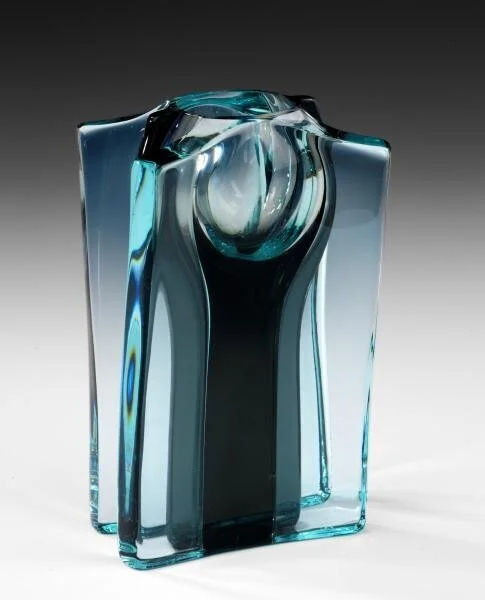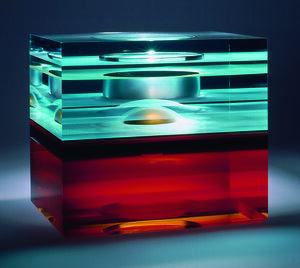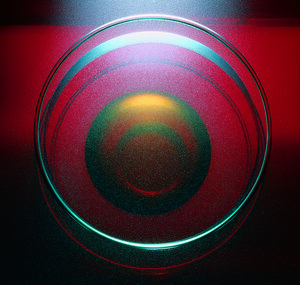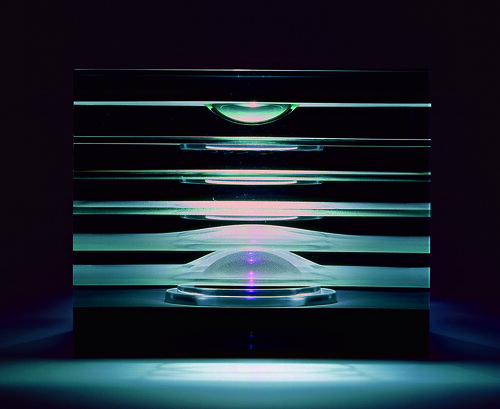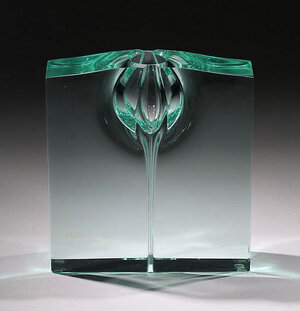
“Thomas Patti is much more concerned with designing specifically for the medium than are most studio glass artists... His works have about them a degree of intellectual discipline that lend them a classic serenity.”
MUSEUM OF MODERN ART
EXHIBITION
“The American Studio Glass Movement began in 1963, benefiting from a technology that for the first time allowed glass to be made at home - to become, as it were, a cottage industry. It was now possible for the artist who designed objects in glass to also make them, rather than turning his ideas over to craftsmen working in a glass factory, and this encouraged many young designers and artists to experiment with glass as a creative medium. Most of those who did so rejected conventional utilitarian forms and sought instead to express themselves through glass sculpture.
Thomas Patti is much more concerned with designing specifically for the medium than are most studio glass artists. He builds his forms by cutting sheets of glass (some of which may be colored or textured), sandwiching them together, laminating them with heat, and then blowing them into shapes. His works have about them a degree of intellectual discipline that lend them a classic serenity.” - MOMA
SOLAR BRONZE RISER Vase 1978 Blown, laminated glass Zaidee Dufallo Fund. 258.79
THE COLLECTION
METROPOLITAN MUSEUM OF ART
EXHIBITION
“Patti graduated from Pratt Institute with a Master’s Degree in industrial design. His earliest work included geodesic domes, furniture and utilitarian objects. By the late 1970s, however, he turned to making intimate-sized sculptures from layers of plate glass. These geometric forms became icons of the contemporary art world. Patti continued to investigate the artistic and industrial properties of glass through architectural commissions. He recently experimented with the use of his own custom-laminated, light-directional reflective glass for this table design.” - THE MET
ROTATED RECTANGLE (In memory of Rowena Reed) 2009 | Custom laminated light directional reflective glass, wrinkle finish powder paint on steel
THE COLLECTION
MET COLLECTION: BURGUNDY LUMINA STARPHIRE WITH GREEN | BANDED FLAIR | SPLIT VERTICAL VERTEX
SMITHSONIAN AMERICAN ART MUSEUM
THE COLLECTION
“The opening for me is the hidden complexity of something solid that has an interior, a thin wall within a thick wall. The opening appears and disappears as your eye moves over the piece; it’s not asking you to look in, it’s a three dimensional volume inside a series of two dimensional forms.”
ART INSTITUTE CHICAGO
THE COLLECTION
“Thomas Patti was trained in industrial design at the Pratt Institute, and his interest in glass grew out of academic investigations into the nexus of art, engineering, and architecture. Patti’s work is nonfunctional and deals with the potential of the form, particularly the question of how to juxtapose pieces of glass. This piece invites the viewer to look into the glass (preferably with the aid of light transmitted from below) in order to appreciate the geometric yet delicate quality of the layers of glass.”
ART INSTITUTE CHICAGO COLLECTION: Red Lumina with Concentric Disc
CORNING MUSEUM OF GLASS
THE COLLECTION
“A widely respected artist and studio glass pioneer, Patti has devoted much of his career to researching special glasses and hot-forming techniques. He began to work with glass during the early years of the Studio Glass movement, but he chose to explore industrial sheet glass, rather than blown glass, as the material for his art. Over the last 35 years, Patti has used glass to build and define architectonic spaces that transform surface, light, and color, fusing layers of glass with bubbles and other spatial elements into unique works. Although his sculptures are small, the strength of the forcefully compressed layers of glass makes them physically imposing.”
YALE UNIVERSITY ART GALLERY
THE COLLECTION
“[Patti] views his work as a continuous investigation “of a process, of a way of thinking,” an approach informed by his training as an industrial designer.”
YALE UNIVERSITY ART COLLECTION: AMERICAN DECORATIVE ARTS Clear Air-Frame with Pinstripes
MUSEUM OF FINE ARTS BOSTON
The Collection
The Riser Series evolved from 1977-1981. BI-AXIAL TUBATED CLEAR RISER explores form as a composition of plane and space - a three-dimensional fused glass structure composed of transparent commercial sheet glass. Started in 1980, the shape of the work was uniquely refined in 1986. This process of re-working the original piece has become integral to the development of the artist’s work. The small bubble opening at the top is the final resolution of the bulbous forms of 1975-79 where the entire body of the form has been expanded. The bubble has evolved from being the dominant form to a sub-dominant element located within the upper portion of the work. A bubble this size has become the signature of the subsequent work from 1983-94. The Riser series marks the resolution of Tom using the vessel as the context of exploring form. With this object the form and structure are one. The integrity of each element (layer of glass) is exposed to the viewer. The mystery of process is revealed. The vertical "rising" form makes architectural reference to soaring cathedrals. The glass is now freed from its base and supported by an architectural framework.
PERMANENT COLLECTIONS
Berkshire Museum, Pittsfield, MA
Indianapolis Museum of Art, Indianapolis, IN
Museum of Fine Arts, Houston, TX
National Museum of American Art, Washington, DC
Musee des Arts Decoratifs de la Ville de Lausanne, Switzerland
Musee des Arts Decoratifs, Paris, France
Coburg Museum, Coburg, Germany
Philadelphia Museum of Art, Philadelphia, PA
Brockton Art Museum, Brockton, MA
Museum of Modern Art (MoMA), NYC
Metropolitan Museum of Art, NYC
Corning Museum of Glass, Corning, NY
Lobmeyr Museum, Vienna, Austria
Kunstmuseum Dusseldorf, Dusseldorf, Germany
Kestner Museum, Hannover, Germany
Toledo Museum of Art, Toledo, OH
Chrysler Museum, Norfolk, VA
Victoria and Albert Museum, London, England
The Art Institute of Chicago, Chicago, IL
National Gallery of Victoria, Melbourne, Australia
Le Musee des Arts Decoratifs de Montreal, Canada
Museum of Fine Arts, Boston, MA
The Saint Louis Art Museum, St. Louis, MO
The Speed Art Museum, Louisville, KY
Carnegie Museum of Art, Pittsburgh, PA
Mint Museum of Craft + Design, Charlotte, NC
Fuller Museum of Art, Brockton, MA
Smithsonian American Art Museum, Washington, DC
The Eric Carle Museum of Picture Book Art, Amherst, MA
Musee Des Beaux-Arts de Montreal, Canada
Yale University Art Gallery, New Haven, CT
de Young Museum, San Francisco, CA
Museum of Art and Design (MAD), NYC










